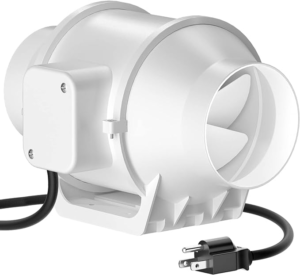An inline fan, also known as an inline duct fan or centrifugal fan, is a type of ventilation device that is mounted inside of ductwork to move air in and out of a space.

Here’s a more detailed breakdown of an inline fan:
Components
1.Housing typically makes of galvanized steel or ABS plastic and houses all the other components of the fan.
2.Impeller is a rotating blade wheel that is responsible for drawing air in and pushing it out. Inline fans can have forward-curved blades or backward-curved blades. Forward-curved blades are more efficient at moving large volumes of air at low static pressure, while backward-curved blades are quieter and more efficient at moving air against higher static pressure.
3.Motor drives the impeller and creates the airflow. Inline fans are available in a variety of motor sizes to match the desired airflow capacity.
4.Speed control: Some inline fans have built-in speed controls or can be used with variable speed controllers to adjust the airflow output.
5.Duct flanges on either end of the housing allow the fan to be easily connected to ductwork.
Working principle
1.The motor spins the impeller blade wheel.
2.As the blades rotate, they draw air in through the inlet of the fan housing.
3.The air is then accelerated by the impeller blades and forced out through the outlet of the fan housing.
4.The ductwork channels the airflow to the desired location.
Applications
1.Bathroom and kitchen ventilation to remove moisture and odors from these spaces, preventing mold and mildew growth.
2.Grow room ventilation are essential for maintaining proper temperature and humidity levels in indoor growing environments.
3.Home ventilation uses to boost the performance of an existing ventilation system or to provide whole-house ventilation.
4.Radon mitigation systems help to remove radon gas from homes.
5.HVAC systems uses to boost airflow in heating and air conditioning systems.
6.Dust collection systems uses to collect dust and debris from workshops and other industrial settings.
Selection factors
1.Size of the inline fan will depend on the amount of airflow that needs for the application. This is typically measured in cubic feet per minute (CFM).
2.Static pressure is the resistance to airflow in the duct system. The inline fan should be able to overcome the static pressure in the duct system in order to deliver the desired airflow.
3.Noise level: Inline fans can generate noise, so it is important to consider the noise level when selecting a fan for a residential application.
4.Speed control: Some applications may require a fan with variable speed control.
Inline fans are available in a variety of sizes and capacities to meet the specific needs of a particular application. They are also relatively easy to install and can be a great way to improve the ventilation in your home.
Looking to install a commercial HVAC System or Duct work in your Business Area?
Contact Vipul Ac to learn about our HVAC Service Call +91 8000092000 Today.
